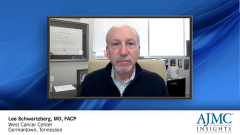
Plinabulin With G-CSF Treatment for CIN Prophylaxis
Lee Schwartzberg, MD, FACP, of the West Cancer Center, highlights exciting data demonstrated by PROTECTIVE-2 study of plinabulin with pegfilgrastim as prevention of chemotherapy-induced neutropenia and implications for using the combination in the future.
Episodes in this series

Lee Schwartzberg, MD, FACP: We have room for new agents in helping us reduce the incidence of CIN [chemotherapy-induced neutropenia] and FN[febrile neutropenia]. There is a new agent called plinabulin, which has shown some interesting and exciting results as an add-on agent for reducing CIN. This agent is different. It’s not a colony-stimulating factor. It appears to be an immune and stem cell modulator, and it has a different mechanism of action than our standard growth factors, which we use in the clinic today.
In a randomized, phase 2 study comparing plinabulin to G-CSF [granulocyte colony-stimulating factor] in moderately myelosuppressive chemotherapy, it showed similar benefits in reducing the duration of severe neutropenia after patients received doses of docetaxel as the single agent. Based on that data it went into phase 3 trials. One of those phase 3 trials is called PROTECTIVE-2, and we saw some of the top-line results, which are exciting.
PROTECTIVE-2 is a study looking at plinabulin given on day 1 after chemotherapy with pegfilgrastim given as standard on day 2 after myelosuppressive chemotherapy in patients with breast cancer receiving a triplet combination of drugs called TAC, for docetaxel, doxorubicin, and cyclophosphamide. We know that this regimen is heavily myelosuppressive, and although pegfilgrastim by itself can reduce the incidence of CIN, it does not completely abrogate it, nor does it abrogate the risk of febrile neutropenia. Those patients in particular with severe myelosuppression do require an additional agent.
The primary end point of PROTECTIVE-2 was to show a reduction in the incidence of grade 4 neutropenia after TAC [docetaxel, doxorubicin, and cyclophosphamide] with the addition of plinabulin to pegfilgrastim, and the top-line results showed that this primary end point was met and was highly statistically significant.
In addition, a secondary end point of the duration of severe neutropenia in the first 8 days after chemotherapy, when plinabulin will be working before G-CSF has a chance to kick in if you will, was also achieved and was highly statistically significant. We have exciting preliminary data that suggest that this combination of plinabulin plus pegfilgrastim can reduce further the risk of CIN that is severe, and therefore the risk of FN, when using the combination approach. We await the final results of this study. This drug did receive breakthrough designation by the FDA.
If plinabulin is approved by the FDA, we would now have a new regimen of likely combination with plinabulin given on day 1 and pegfilgrastim given on day 2 after highly myelosuppressive chemotherapy with the potential benefit of completely doing away with the risk of severe CIN, or at least markedly reducing it from where we are today after highly myelosuppressive chemotherapy.
Newsletter
Stay ahead of policy, cost, and value—subscribe to AJMC for expert insights at the intersection of clinical care and health economics.



























































